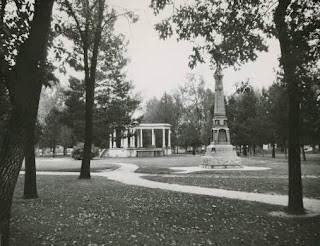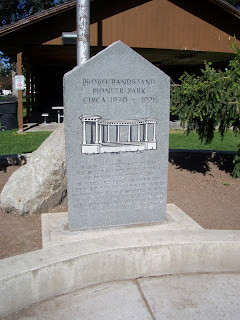Pioneer Park in Provo stands as a testament to the city’s rich history and enduring community spirit. As one of Provo’s oldest parks, boasting over a century of history, it offers a unique glimpse into the past while remaining a vibrant part of the present. A captivating photograph from the 1920s reveals a park landscape that, while familiar in layout, showcases some significant transformations over time.
 Vintage photo of Pioneer Park Provo, circa 1920s, showcasing its historical landscape.
Vintage photo of Pioneer Park Provo, circa 1920s, showcasing its historical landscape.
Photo Courtesy of the L. Tom Perry Special Collections, Brigham Young University
Comparing this historical image with the park’s current appearance reveals fascinating changes. Notably, the iconic pavilion and a now-vanished canal system highlight the park’s evolution to meet the changing needs of the Provo community.
 Pioneer Park Provo in 2011, highlighting the modern park layout and picnic pavilion.
Pioneer Park Provo in 2011, highlighting the modern park layout and picnic pavilion.
The Bandstand to Pavilion Transformation
One of the most significant alterations in Pioneer Park is the replacement of the old bandstand with the current picnic pavilion. A commemorative plaque near the picnic area serves as a reminder of the bandstand’s legacy.
 Memorial plaque at Pioneer Park Provo commemorating the old Provo Bandstand and its history.
Memorial plaque at Pioneer Park Provo commemorating the old Provo Bandstand and its history.
The plaque honors the “Provo Bandstand, Pioneer Park: Circa 1930-1991,” and recognizes the Business and Professional Women’s Club of Provo for funding and building it. Intended to foster public music and arts performances, the bandstand was a hub of community activity. However, the popularity of concerts eventually outgrew the park’s capacity, leading to the relocation of these events to North Park. Subsequently, the bandstand saw less frequent use and gradually deteriorated, becoming both an eyesore and a safety concern.
In 1991, after extensive debate regarding renovation versus replacement, the Provo City Council decided to dismantle the bandstand and construct a picnic pavilion in its place. Despite initial plans to renovate the bandstand, funding challenges and declining usage led to this decision. The plaque serves as a poignant memorial to the bandstand, a sentiment aptly described by Mike Leventhal of the Utah Historical Foundation as, “we killed your grandmother, but here’s a picture of her.”
The Canal’s Journey: From Waterway to Fountain Feature
Another notable change at Pioneer Park is the disappearance of a canal that once flowed north-south along the park’s eastern edge, adjacent to 5th West. Historical records offer glimpses of this canal, which played a role in the park’s early landscape.
While photographic documentation of the canal within Pioneer Park is scarce, its presence is noted in historical accounts and maps of the area. Around 2005, citing safety concerns, the canal was filled in. However, recent developments indicate a renewed appreciation for water features in the park. Plans are underway to introduce a fountain-like feature near the picnic pavilion, in the very area where the bandstand plaque stands. This project aims to revitalize Pioneer Park and create an attractive focal point, especially for visitors to the popular Farmer’s Market held there throughout the summer. This new water feature promises to add a refreshing dimension to Pioneer Park, blending modern amenities with echoes of its historical past.
